Original quantitative research – Pediatric injuries in the time of COVID-19
Health Promotion and Chronic Disease Prevention in Canada
Tell us what you think
Help us improve our products, answer our quick survey.
Glenn Keays, MPHAuthor reference footnote 1Author reference footnote 2; Debbie Friedman, BSc pht, MMgmtAuthor reference footnote 1Author reference footnote 2Author reference footnote 3Author reference footnote 4; Isabelle Gagnon, PT, PhDAuthor reference footnote 5Author reference footnote 6
https://doi.org/10.24095/hpcdp.40.11/12.02
(Published September 11, 2020)
This article has been peer reviewed.
Correspondence: Glenn Keays , McGill University Health Centre, Montreal Children’s Hospital, 1001 Boulevard Décarie, Room B.S1.2766.2, Montréal, QC H4A 3J1; Tel: (514) 412-4400 ext. 23167; Email: Glenn.Keays@muhc.mcgill.ca
Abstract
Introduction: Research has shown that during the 2003 SARS pandemic, emergency department (ED) visits among the pediatric population decreased. We set out to investigate if this was also true for injury-related ED visits during the COVID-19 pandemic.
Methods: Using data from the Canadian Hospitals Injury Reporting and Prevention Program (CHIRPP), we looked at 28 years of injury-related ED visits at the Montreal Children’s Hospital, a provincially designated Pediatric Trauma Centre. We compared data from a two-month period during the COVID-19 lockdown (16 March to 15 May) to the same period in previous years (1993–2019) to determine whether the 2020 decrease in ED visit numbers was unprecedented (i.e. a similar decrease had never occurred) for different age groups, nature of injuries, mechanisms and severity.
Results: The 2020 decrease was unprecedented across all age groups between 1993 and 2019. When compared with the 2015 to 2019 average, the decrease was smallest in children aged 2 to 5 years (a 35% decrease), and greatest in the group aged 12 to 17 years (83%). Motor vehicle collisions and sports-related injuries practically vanished during the COVID-19 lockdown. Surprisingly, more children aged 6 to 17 years presented with less urgent injuries during the COVID-19 lockdown than in previous years.
Conclusion: As was the case with SARS in 2003, COVID-19 acted as a deterrent for pediatric ED visits. The lockdown in particular had a profound impact on injury-related visits. The de-confinement period will be monitored to determine the impact in both the short and the long term.
Keywords: COVID-19, adolescents, children, emergency, epidemiology, primary care, wounds, injuries
Highlights
- During the COVID-19 lockdown in Montréal (16 March to 15 May, 2020) ED visits by children aged 0 to 17 years decreased by 72% compared to the average of the previous 5 years.
- In the same period, children’s (aged 0–17 years) injury-related ED visits decreased by 62% compared to the average of the previous 5 years.
- The decrease in numbers was unprecedented over the past 28 years for fractures and mild traumatic brain injuries in children aged 6 to 17 years; for burns in children aged 0 to 5 years; and for motor vehicle collisions (all ages) and sports-related injuries (all ages).
Introduction
In his book Love in the Time of Cholera, Gabriel García Márquez explores a universal and age-old theme: during pandemics, life goes on. Unfortunately, that includes injuries. While one might not immediately associate a disease pandemic with injuries to children, it remains that the one might influence the other.
Rates of injuries in children and adolescents have been shown to fluctuate from one year to the next,Footnote 1Footnote 2Footnote 3Footnote 4Footnote 5Footnote 6 but also within each year according to seasonal variations.Footnote 6Footnote 7Footnote 8Footnote 9Footnote 10Footnote 11Footnote 12Footnote 13 At the onset of the COVID-19 lockdown in Montréal on 16 March, 2020, when schools and daycares closed and all organized sporting activities stopped, we anticipated a decrease in the number of children presenting with an injury to the emergency department (ED) of the Montreal Children’s Hospital (MCH) Pediatric and Adolescent Trauma Centre.
We looked first at the data from the 2003 SARS outbreak. While we did find research addressing reduced ED visit rates for children during that time, we did not find any papers specifically addressing the impact upon injury rates in the pediatric population. We then set out to determine and document the evolving impact that the COVID-19 lockdown had on ED visits related to injuries in the pediatric population (aged 0–17 years) according to the age of the child, the mechanism of injury, and the nature and the severity of the injury.
Methods
We retrieved data from the Canadian Hospitals Injury Reporting and Prevention Program (CHIRPP), created in 1990 by the Public Health Agency of Canada to provide a broader understanding of injuries, especially those in the pediatric population (aged under 18 years), by gathering data from emergency visits from 10 pediatric hospitals. As of 2020, CHIRPP has over 3.5 million records and has been expanded to gather data from 19 hospitals across the country: 11 pediatric and 8 general.Footnote 14
As per the CHIRPP protocol at Montreal Children’s Hospital Pediatric and Adolescent Trauma Centre, patients or parents of patients who presented to the ED for assessment and treatment of an injury were asked to fill out a one-page questionnaire and provide detailed information about the injury, such as when, where and how it happened. In addition, clinical data, such as the nature of the injury, body part and type of treatment, were extracted from the ED record by the CHIRPP coordinator. For cases in which there was no CHIRPP form filled out by families, information was extracted from the patients’ medical records by the coordinator. In order to ensure full confidentiality, the patient’s hospital medical record number was scrambled, and the child’s date of birth was rounded off to 15 or 31, depending on the day of the month the child was born. This was done prior to submission of the information to the central CHIRPP data centre in Ottawa. The Montreal Children’s Hospital CHIRPP system captures over 97% of all ED injury-related visits occurring at the institution.
To document the decrease in number of injury-related visits during the COVID-19 lockdown period, we opted to do a comparison of the same period of time over 28 years, from 1993 to 2020. We restricted the cases to patients that visited the ED during the period from 16 March to 15 May (which corresponds to two months of COVID-19 lockdown in Montréal) for each of the 28 years. We separated children into four age groups: toddlers (aged 0–1 year), pre-school (2–5 years), elementary school (6–11 years) and high school (12–17 years.)
We limited our injury mechanisms to three categories. The first one, motor vehicle collisions (MVCs), was an obvious choice, as traffic decreased in Montréal during the lockdown. The second, sports-related injuries, was chosen because sports and recreational activities were not allowed during the COVID-19 lockdown. We included sports injuries that occurred in both organized settings and informal ones, and limited the sports to the following: ice hockey, football, soccer, basketball, rugby, skiing and snowboarding. The third category was injuries that occurred during recreational activities, which included cycling, skateboarding, scootering (push scooter) and trampoline (residential backyard trampolines).
To determine variations in injury severity, we used the ED triage scale (Canadian Triage and Acuity Scale)Footnote 15Footnote 16 to verify our hypothesis that during COVID-19 lockdown there would be a greater proportion of children presenting with urgent or severe injuries. We calculated the proportion of triage levels 1 (resuscitation), 2 (emergent) and 3 (urgent) for each year between 2010 and 2020 (we could not use years prior to 2010 because triage protocol changed at the MCH ED in 2009).
Statistical analysis
Results are presented as plotted graphs for each age group and then further broken down by specific injuries. Given that there were demographic changes over the long study period, we limited our average calculations to the number of patients seen during the previous five years (2015–2019). We calculated 95% confidence intervals (CIs) for each average. Calculations and analyses were performed using SPSS software version 17.0 (IBM Corp., Armonk, NY, USA).
Results
From 2015 to 2019, an average of 14 016 children (95% CI: 13 242–14 789) visited the MCH ED in the two-month period between 16 March and 15 May; in 2020, it was 3909—a 72% decrease. When we considered only those consulting for an injury, we found there was still a marked reduction, from an average of 2774 (95% CI: 2623–2924) down to 1052 in 2020—a 62% decrease.
The decreases in injury-related ED visits varied according to the age of the child (Figure 1). In toddlers aged 0 to 1 year, the lowest number seen over the 28-year period was 275 in 1999, while in 2020 it was 230. In preschoolers aged 2 to 5 years, the lowest number recorded was 500 in 2003, compared to 441 in 2020. When looking at the average for the years 2015 to 2019, we found the decrease was greater for toddlers (a 45% decrease from an average of 415 [95% CI: 377–453]) than for preschoolers (a 35% decrease from an average of 676 [95% CI: 637–715]).
Figure 1. Number of injury-related visits to Montreal Children’s Hospital emergency department, per age group, from 16 March to 15 May, 1993 to 2020
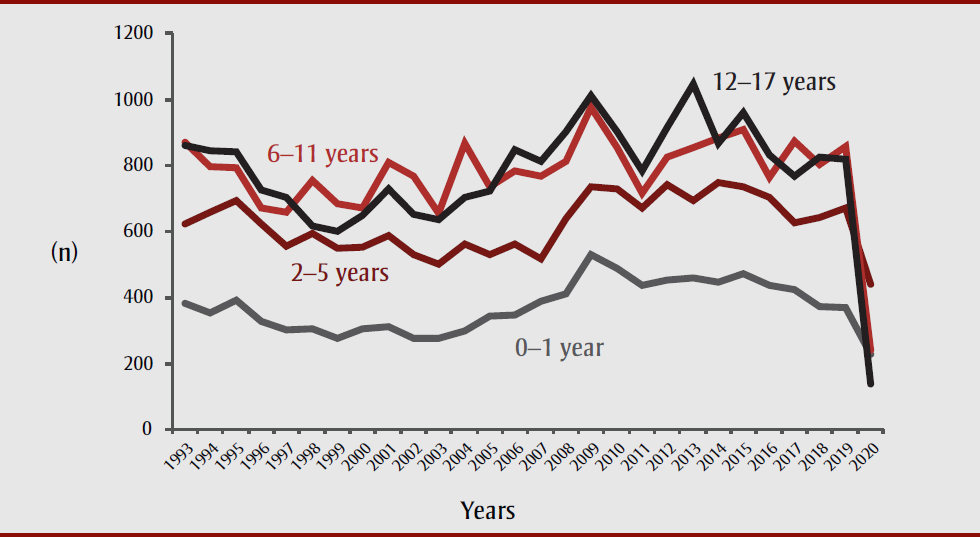
Text description: Figure 1
Figure 1. Number of injury-related visits to Montreal Children’s Hospital emergency department, per age group, from 16 March to 15 May, 1993 to 2020
| Year | 0–1 year | 2–5 years | 6–11 years | 12–17 years |
|---|---|---|---|---|
| 1993 | 383 | 622 | 871 | 862 |
| 1994 | 355 | 660 | 796 | 845 |
| 1995 | 393 | 693 | 794 | 842 |
| 1996 | 327 | 624 | 670 | 726 |
| 1997 | 301 | 557 | 658 | 702 |
| 1998 | 307 | 594 | 756 | 618 |
| 1999 | 275 | 550 | 684 | 601 |
| 2000 | 307 | 554 | 670 | 649 |
| 2001 | 313 | 589 | 811 | 729 |
| 2002 | 275 | 531 | 769 | 652 |
| 2003 | 275 | 500 | 656 | 635 |
| 2004 | 300 | 561 | 868 | 703 |
| 2005 | 343 | 530 | 736 | 723 |
| 2006 | 347 | 562 | 785 | 848 |
| 2007 | 389 | 516 | 767 | 813 |
| 2008 | 410 | 639 | 812 | 903 |
| 2009 | 531 | 737 | 978 | 1013 |
| 2010 | 490 | 729 | 853 | 901 |
| 2011 | 438 | 673 | 716 | 784 |
| 2012 | 453 | 741 | 824 | 915 |
| 2013 | 461 | 693 | 856 | 1046 |
| 2014 | 448 | 749 | 884 | 867 |
| 2015 | 472 | 735 | 908 | 959 |
| 2016 | 437 | 705 | 766 | 832 |
| 2017 | 425 | 625 | 874 | 768 |
| 2018 | 373 | 643 | 802 | 825 |
| 2019 | 369 | 672 | 859 | 819 |
| 2020 | 230 | 441 | 241 | 139 |
For elementary school children, aged 6 to 11 years, the record low number was 656 in 2003 (241 in 2020), while for high school–aged children from 12 to 17 years, the lowest number was 601 in 1999 (down to 139 in 2020). When looking at the average for 2015 to 2019 for these groups, we found the decrease was greater for high school–aged children (an 83% decrease from an average of 841 [95% CI: 779–902]) than for elementary school children (a 71% decrease from an average of 842 [95% CI: 792–892]. The gender of children visiting the ED did not vary; it averaged 55.4% males [95% CI: 54.3%-57.4%] between 2015 and 2019, and was 55.8% in 2020.
The decrease in numbers also varied by the type of injury and by age. To simplify the figures, we separated children into two age groups, 0 to 5 years and 6 to 17, and only looked at four types of injuries: fractures, mild traumatic brain injuries (mTBI), burns and poisonings. In children aged 0 to 5 years, only burns showed an unprecedented decrease (i.e. a similar decrease had never occurred in the study period): 15 cases in 2014 versus 10 in 2020 (Figure 2 and Figure 3). When the 2015 to 2019 average was used, the decrease in 2020 was statistically significant in mTBI (a 44% decrease, from 285 [95% CI: 260–310] down to 160); in fractures (a 33% decrease, from 132 [95% CI: 114–151] down to 88); and in burns (a 55% decrease, from 22 [95% CI: 17–28] down to 10).
Figure 2. Number of visits to Montreal Children’s Hospital emergency department for mild traumatic brain injuries and fractures in children aged 0 to 5 years, from 16 March to 15 May, 1993 to 2020

Text description: Figure 2
Figure 2. Number of visits to Montreal Children’s Hospital emergency department for mild traumatic brain injuries and fractures in children aged 0 to 5 years, from 16 March to 15 May, 1993 to 2020
| Year | Fractures | Mild traumatic brain injuries |
|---|---|---|
| 1993 | 99 | 105 |
| 1994 | 105 | 124 |
| 1995 | 113 | 175 |
| 1996 | 112 | 121 |
| 1997 | 92 | 128 |
| 1998 | 115 | 171 |
| 1999 | 90 | 178 |
| 2000 | 103 | 182 |
| 2001 | 122 | 180 |
| 2002 | 85 | 164 |
| 2003 | 72 | 149 |
| 2004 | 100 | 243 |
| 2005 | 81 | 261 |
| 2006 | 97 | 218 |
| 2007 | 94 | 247 |
| 2008 | 139 | 227 |
| 2009 | 140 | 465 |
| 2010 | 145 | 282 |
| 2011 | 117 | 271 |
| 2012 | 128 | 313 |
| 2013 | 134 | 338 |
| 2014 | 129 | 337 |
| 2015 | 166 | 323 |
| 2016 | 139 | 276 |
| 2017 | 121 | 302 |
| 2018 | 123 | 279 |
| 2019 | 113 | 247 |
| 2020 | 88 | 160 |
Figure 3. Number of visits to Montreal Children’s Hospital emergency department for burns and poisonings in children aged 0 to 5 years, from 16 March to 15 May, 1993 to 2020
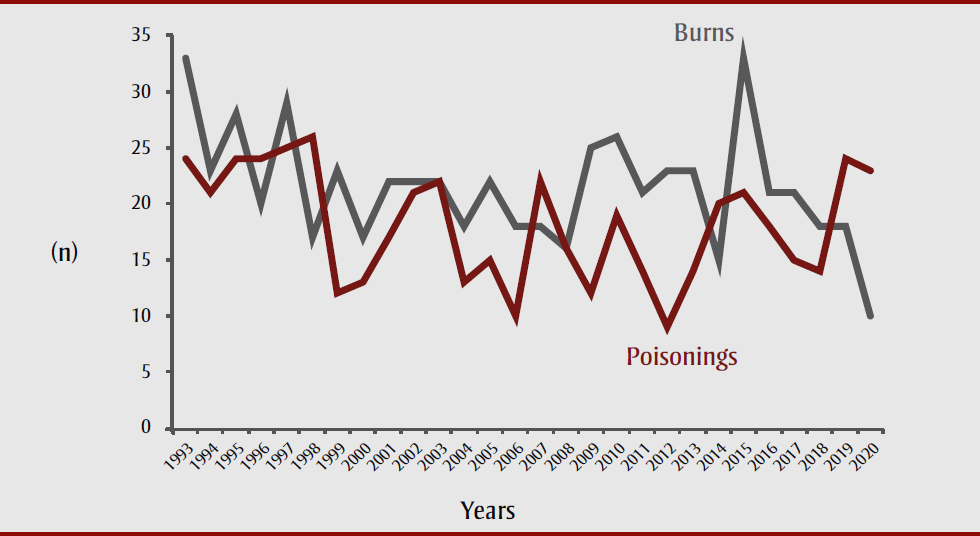
Text description: Figure 3
Figure 3. Number of visits to Montreal Children’s Hospital emergency department for burns and poisonings in children aged 0 to 5 years, from 16 March to 15 May, 1993 to 2020
| Year | Burns | Poisonings |
|---|---|---|
| 1993 | 33 | 24 |
| 1994 | 23 | 21 |
| 1995 | 28 | 24 |
| 1996 | 20 | 24 |
| 1997 | 29 | 25 |
| 1998 | 17 | 26 |
| 1999 | 23 | 12 |
| 2000 | 17 | 13 |
| 2001 | 22 | 17 |
| 2002 | 22 | 21 |
| 2003 | 22 | 22 |
| 2004 | 18 | 13 |
| 2005 | 22 | 15 |
| 2006 | 18 | 10 |
| 2007 | 18 | 22 |
| 2008 | 16 | 16 |
| 2009 | 25 | 12 |
| 2010 | 26 | 19 |
| 2011 | 21 | 14 |
| 2012 | 23 | 9 |
| 2013 | 23 | 14 |
| 2014 | 15 | 20 |
| 2015 | 33 | 21 |
| 2016 | 21 | 18 |
| 2017 | 21 | 15 |
| 2018 | 18 | 14 |
| 2019 | 18 | 24 |
| 2020 | 10 | 23 |
In children aged 6 to 17 years, the decrease in 2020 was unprecedented for fractures (129 in 2020 vs. 265 in 1997) and mTBI (20 in 2020 vs. 75 in 1993). All injuries showed a statistically significant decrease in 2020 in comparison to the 2015 to 2019 average: there was a 70% decrease for fractures (428 [95% CI: 400–456] down to 129); a 93% decrease for mTBI (295 [95% CI: 269–322] down to 20); a 61% decrease for poisonings (36 [95% CI: 29–43] down to 14); and a 47% decrease for burns (8 [95% CI: 5–10] down to 4 (Figure 4 and Figure 5 ).
Figure 4. Number of visits to Montreal Children’s Hospital emergency department for mild traumatic brain injuries and fractures in children aged 6 to 17 years, from 16 March to 15 May, 1993 to 2020
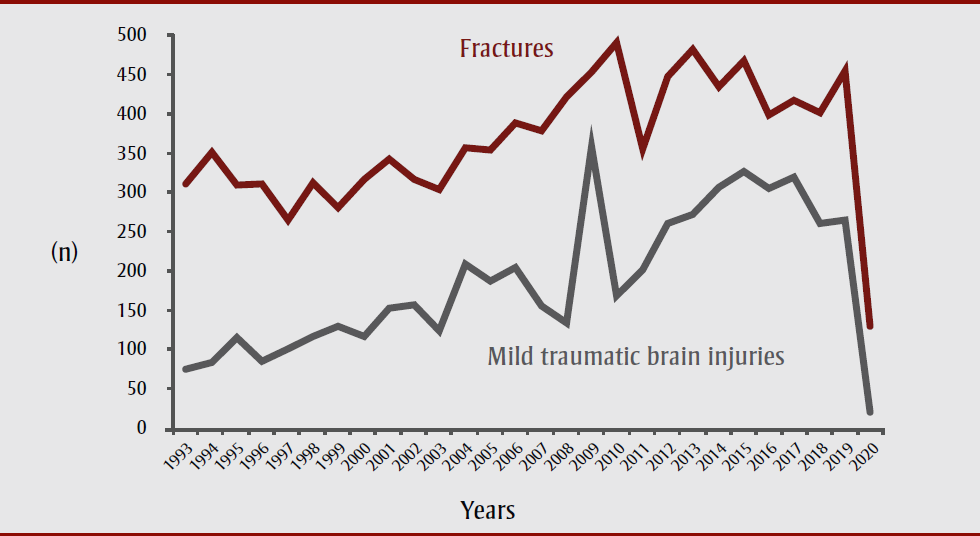
Text description: Figure 4
Figure 4. Number of visits to Montreal Children’s Hospital emergency department for mild traumatic brain injuries and fractures in children aged 6 to 17 years, from 16 March to 15 May, 1993 to 2020
| Year | Fractures | Mild traumatic brain injuries |
|---|---|---|
| 1993 | 311 | 75 |
| 1994 | 351 | 83 |
| 1995 | 309 | 115 |
| 1996 | 311 | 85 |
| 1997 | 265 | 101 |
| 1998 | 312 | 117 |
| 1999 | 280 | 129 |
| 2000 | 317 | 117 |
| 2001 | 343 | 153 |
| 2002 | 317 | 157 |
| 2003 | 304 | 124 |
| 2004 | 357 | 208 |
| 2005 | 354 | 187 |
| 2006 | 388 | 204 |
| 2007 | 379 | 155 |
| 2008 | 421 | 133 |
| 2009 | 453 | 358 |
| 2010 | 491 | 168 |
| 2011 | 355 | 202 |
| 2012 | 447 | 261 |
| 2013 | 482 | 272 |
| 2014 | 434 | 307 |
| 2015 | 468 | 326 |
| 2016 | 398 | 305 |
| 2017 | 417 | 319 |
| 2018 | 402 | 261 |
| 2019 | 455 | 265 |
| 2020 | 129 | 20 |
Figure 5. Number of visits to Montreal Children’s Hospital emergency department for burns and poisonings in children aged 6 to 17 years, from 16 March to 15 May, 1993 to 2020

Text description: Figure 5
Figure 5. Number of visits to Montreal Children’s Hospital emergency department for burns and poisonings in children aged 6 to 17 years, from 16 March to 15 May, 1993 to 2020
| Year | Burns | Poisonings |
|---|---|---|
| 1993 | 19 | 25 |
| 1994 | 9 | 26 |
| 1995 | 8 | 9 |
| 1996 | 5 | 14 |
| 1997 | 8 | 17 |
| 1998 | 6 | 13 |
| 1999 | 11 | 23 |
| 2000 | 5 | 16 |
| 2001 | 9 | 24 |
| 2002 | 10 | 17 |
| 2003 | 5 | 17 |
| 2004 | 11 | 21 |
| 2005 | 7 | 11 |
| 2006 | 10 | 26 |
| 2007 | 3 | 28 |
| 2008 | 14 | 20 |
| 2009 | 10 | 30 |
| 2010 | 6 | 27 |
| 2011 | 6 | 18 |
| 2012 | 6 | 26 |
| 2013 | 5 | 30 |
| 2014 | 10 | 20 |
| 2015 | 8 | 27 |
| 2016 | 5 | 31 |
| 2017 | 7 | 34 |
| 2018 | 5 | 46 |
| 2019 | 13 | 42 |
| 2020 | 4 | 14 |
With regard to the mechanism of injury, we looked at recreational activities, sports-related and motor vehicle–related injuries. We examined four recreational activities specifically: cycling, skateboarding, scootering (push scooter) and trampoline (residential backyard trampolines). The COVID-19 lockdown did not yield any unprecedented results or significant changes from the past-five-year average. The one exception was cycling: injuries related to cycling had been steadily declining over the years and spiked during the COVID-19 lockdown (Figure 6).
Figure 6. Number of visits to Montreal Children’s Hospital emergency department for injuries related to recreational activities, in children aged 0 to 17 years, from 16 March to 15 May, 1993 to 2020
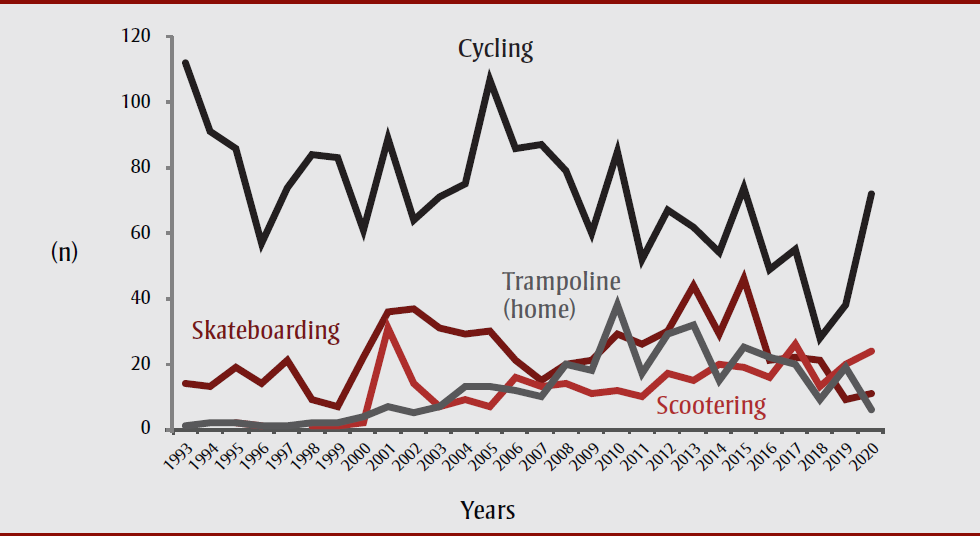
Text description: Figure 6
Figure 6. Number of visits to Montreal Children’s Hospital emergency department for injuries related to recreational activities, in children aged 0 to 17 years, from 16 March to 15 May, 1993 to 2020
| Year | Cycling | Skateboarding | Scootering | Trampoline (home) |
|---|---|---|---|---|
| 1993 | 112 | 14 | 3 | 1 |
| 1994 | 91 | 13 | 2 | |
| 1995 | 86 | 19 | 2 | 2 |
| 1996 | 57 | 14 | 1 | 1 |
| 1997 | 74 | 21 | 1 | |
| 1998 | 84 | 9 | 1 | 2 |
| 1999 | 83 | 7 | 1 | 2 |
| 2000 | 61 | 22 | 2 | 4 |
| 2001 | 89 | 36 | 31 | 7 |
| 2002 | 64 | 37 | 14 | 5 |
| 2003 | 71 | 31 | 7 | 7 |
| 2004 | 75 | 29 | 9 | 13 |
| 2005 | 107 | 30 | 7 | 13 |
| 2006 | 86 | 21 | 16 | 12 |
| 2007 | 87 | 15 | 13 | 10 |
| 2008 | 79 | 20 | 14 | 20 |
| 2009 | 60 | 21 | 11 | 18 |
| 2010 | 85 | 29 | 12 | 38 |
| 2011 | 52 | 26 | 10 | 17 |
| 2012 | 67 | 30 | 17 | 29 |
| 2013 | 62 | 44 | 15 | 32 |
| 2014 | 54 | 29 | 20 | 15 |
| 2015 | 74 | 46 | 19 | 25 |
| 2016 | 49 | 21 | 16 | 22 |
| 2017 | 55 | 22 | 26 | 20 |
| 2018 | 28 | 21 | 13 | 9 |
| 2019 | 38 | 9 | 20 | 19 |
| 2020 | 72 | 11 | 24 | 6 |
MVCs and sports-related injuries saw the most drastic decreases of all of the mechanisms. For all children, aged 0 to 17 years, the lowest number of motor vehicle–related injuries on record was 19 in 1995; in 2020 it was only 3 (Figure 7), a 99% decrease compared to the 2015 to 2019 average of 50 (95% CI: 46–53). For sports-related injuries, the lowest number was 279 in 2011; in 2020 it was only 17 (Figure 8). As with MVCs, this represents a 99% decrease compared to the 2015 to 2019 average of 520 (95% CI: 481–559).
Figure 7. Number of visits to Montreal Children’s Hospital emergency department for motor vehicle–related injuries in children aged 0 to 17 years, from 16 March to 15 May, 1993 to 2020
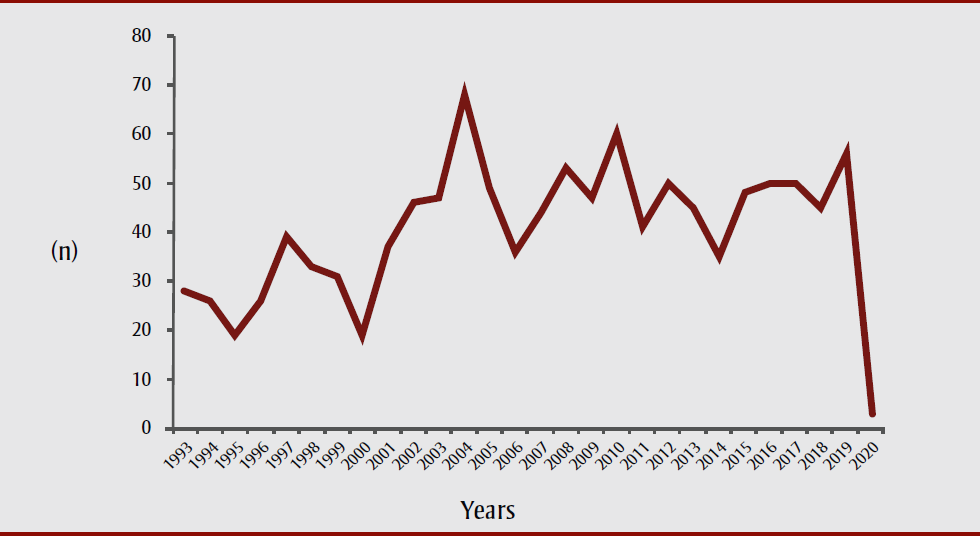
Text description: Figure 7
Figure 7. Number of visits to Montreal Children’s Hospital emergency department for motor vehicle–related injuries in children aged 0 to 17 years, from 16 March to 15 May, 1993 to 2020
| Year | Motor vehicle–related injuries |
|---|---|
| 1993 | 28 |
| 1994 | 26 |
| 1995 | 19 |
| 1996 | 26 |
| 1997 | 39 |
| 1998 | 33 |
| 1999 | 31 |
| 2000 | 19 |
| 2001 | 37 |
| 2002 | 46 |
| 2003 | 47 |
| 2004 | 68 |
| 2005 | 49 |
| 2006 | 36 |
| 2007 | 44 |
| 2008 | 53 |
| 2009 | 47 |
| 2010 | 60 |
| 2011 | 41 |
| 2012 | 50 |
| 2013 | 45 |
| 2014 | 35 |
| 2015 | 48 |
| 2016 | 50 |
| 2017 | 50 |
| 2018 | 45 |
| 2019 | 56 |
| 2020 | 3 |
Figure 8. Number of visits to Montreal Children’s Hospital emergency department for sports-relatedFigure 8 footnote a injuries in children aged 0 to 17 years, from 16 March to 15 May, 1993 to 2020
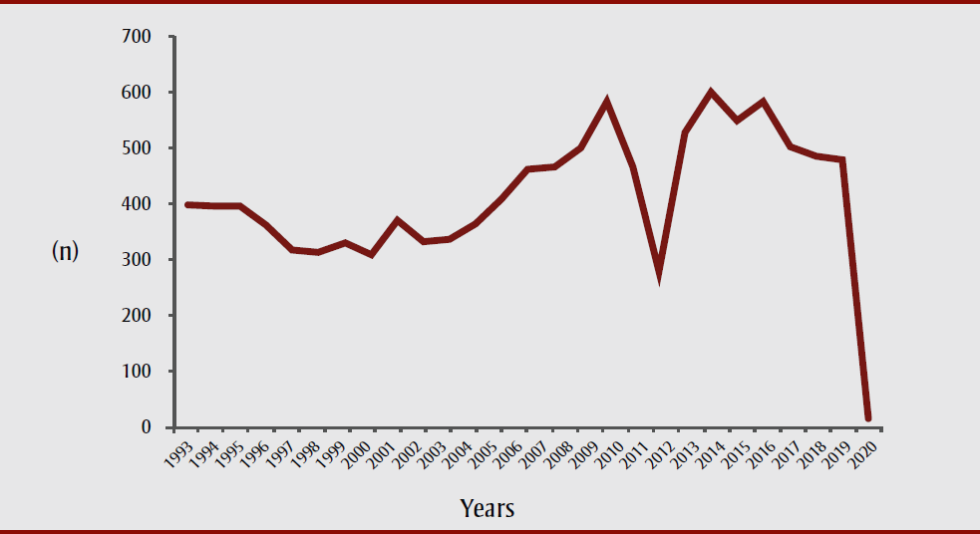
Text description: Figure 8
Figure 8. Number of visits to Montreal Children’s Hospital emergency department for sports-relatedFigure 8 footnote a injuries in children aged 0 to 17 years, from 16 March to 15 May, 1993 to 2020
| Year | Sports-related injuries |
|---|---|
| 1993 | 398 |
| 1994 | 397 |
| 1995 | 396 |
| 1996 | 362 |
| 1997 | 317 |
| 1998 | 314 |
| 1999 | 330 |
| 2000 | 309 |
| 2001 | 371 |
| 2002 | 333 |
| 2003 | 338 |
| 2004 | 365 |
| 2005 | 410 |
| 2006 | 462 |
| 2007 | 467 |
| 2008 | 501 |
| 2009 | 584 |
| 2010 | 467 |
| 2011 | 279 |
| 2012 | 529 |
| 2013 | 601 |
| 2014 | 549 |
| 2015 | 583 |
| 2016 | 503 |
| 2017 | 486 |
| 2018 | 479 |
| 2019 | 17 |
| 2020 | 398 |
With regard to a change in severity for all injury-related visits, the proportion of urgent triage (those coded 1 to 3 by the ED triage nurse) remained the same for children aged 0 to 5 years. Surprisingly, for those aged 6 to 17 years, the March-to-May lockdown period in 2020 saw the lowest percentage of urgent/severe injury-related cases, a 63% decrease from the 2015 to 2019 average of 52% [95% CI: 48%–56%] down to 19% in 2020 (Figure 9).
Figure 9. Proportion of urgent triageFigure 9 footnote a injury-related visits to Montreal Children’s Hospital emergency department in children aged 6 to 17 years, from 16 March to 15 May, 2010 to 2020
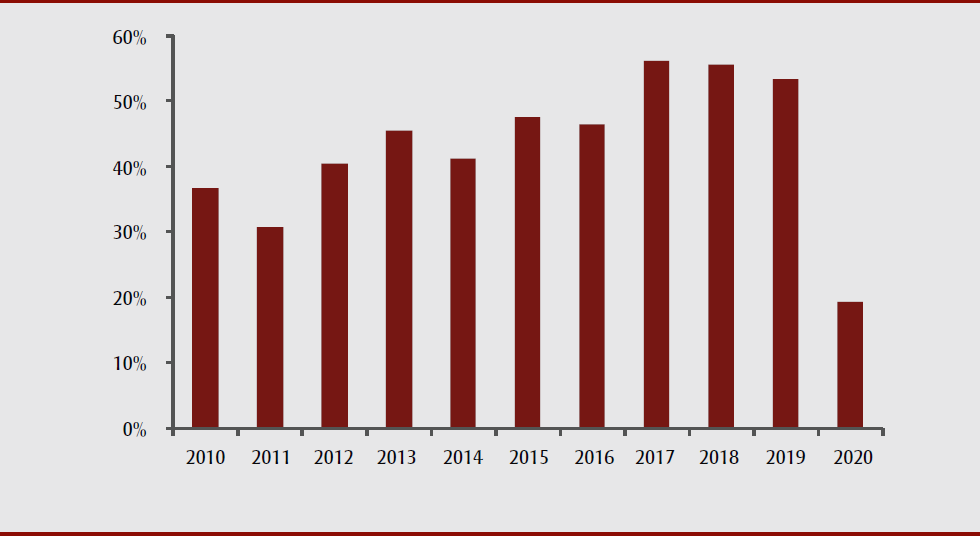
Text description: Figure 9
Figure 9. Proportion of urgent triageFigure 9 footnote a injury-related visits to Montreal Children’s Hospital emergency department in children aged 6 to 17 years, from 16 March to 15 May, 2010 to 2020
| Year | Proportion of urgent triagea injury-related visits |
|---|---|
| 2010 | 37% |
| 2011 | 31% |
| 2012 | 40% |
| 2013 | 45% |
| 2014 | 41% |
| 2015 | 48% |
| 2016 | 46% |
| 2017 | 56% |
| 2018 | 56% |
| 2019 | 53% |
| 2020 | 19% |
Discussion
We determined that the COVID-19 lockdown had a drastic impact on children’s (aged 0–17 years) ED visits. Studies on the SARS 2003 pandemic also pointed to a decrease in pediatric visits to the ED.Footnote 17Footnote 18Footnote 19 One study from Italy on COVID-19 has also reported a decrease in pediatric ED visits.Footnote 20 However, if we use the same age group as a Toronto study on the impact of SARS 2003,Footnote 17 we get opposite results (i.e. the decrease in number of cases in the Toronto study was greatest in the youngest age group and lowest in the oldest).
The reduction in MVCs during the COVID-19 lockdown is already making news. A report from the Road Ecology Center estimated a 50% reduction in MVCs in California.Footnote 21 Seattle and San Francisco also reported a 50% reduction.Footnote 22 We cannot conclude that our nearly 100% decrease in ED visits due to MVCs is reflective of the current number of MVCs in Montréal, but it does point to a substantial reduction in MVCs during COVID-19 times.
We could not find anything in the press or the scientific literature regarding the decrease in sports-related injuries during the COVID-19 lockdown, or during SARS, for that matter. Because the lockdown forced children and teenagers to stop practising sports, it did not surprise us that it was responsible for a nearly 100% decrease in injuries usually sustained through these activities. It will be interesting to monitor the situation and determine if a two-month period of inactivity will have an impact on sports-related injuries when they reappear.
The decrease in severe/urgent visits for school-aged children (aged 6–17 years) during the COVID-19 lockdown is hard to explain. Interestingly, there were more patients presenting to the ED with nonurgent or mild injuries during this period, which was contrary to what might be expected—that is, that these patients would stay away from the ED for fear of catching COVID-19. It is unclear how to explain these results, as there is nothing in the scientific literature that could shed some light on this issue.
Of interest: five children (aged 0–6 years) consulted our ED (3 were hospitalized) following intoxication from cannabis products (mostly edibles) during the 2020 COVID-19 lockdown. Cannabis intoxication in children aged 0 to 3 years is extremely rare at our ED. In the past 28 years, during the same two-month period, it has only occurred three times: in 1995, 2004 and 2006.
Strengths and limitations
A major strength of this study is that it relied on data collected over a very long period of time, and not just on a year-before/year-after design, as many studies have done. Data collected over a short time frame may indicate a striking change between one year and the next, but not reveal whether this change was unprecedented. Another strength of this study is that although the data come from only one hospital, they relied on large numbers, allowing for small confidence intervals and thus better inference.
The main limitation of this study is that it relied on data from one hospital and cannot be used to infer trends over the general population. While the decrease in pediatric injury-related ED visits is significant and unprecedented, we cannot determine whether there really were fewer injuries, or whether the decrease was a social response to COVID-19. Parents may have decided not to consult or decided to visit private clinics instead of pediatric EDs, which could mean we are overestimating the reduction our results suggest.
During COVID-19, patients (or their parents) visiting the ED were not given CHIRPP questionnaires to fill out for fear of disease transmission; this resulted in a loss of detail, as the information we used came from ED reports. This would have mattered had we chosen to look at specific narratives (e.g. cyclists on bike paths, falls from monkey bars at the local parks, etc.). It is the main reason we did not report on home injuries—the location of the injury is rarely present on the ED report, unlike CHIRPP, and since the 2020 data relied heavily on ED report, information regarding where the injury occurred was missing. It might be tempting to assume that most injuries occurred at home during the lockdown but we cannot be certain (in fact, some of the few CHIRPP reports we received during this period stated that the injury occurred at the grandparents’ residence, and others in skate parks, both of which were off limits during lockdown). Nevertheless, our capture rate remained the same for the entire period 1993 to 2020 (between 97% and 98% of all injury-related ED visits were included), and thus we believe our results to be valid, since none of the variables studied (age, gender, and type of injuries) were missing.
Conclusion
The ED department of the Montreal Children’s Hospital Pediatric and Adolescent Trauma Centre saw drastic and often unprecedented decreases in pediatric visits during the two-month COVID-19 lockdown period. The decreases were most evident for school-aged children (aged 6–11 years). Injury mechanisms such as MVCs and sports-related injuries practically vanished during lockdown. We hope that others will review their injury-related ED visits during the period of lockdown associated with COVID-19 to help ascertain whether our observed reduction in injuries presenting to the ED remains true across a more generalizable pediatric sample.
Acknowledgements
This research was made possible from a grant from the Public Health Agency of Canada.
Conflicts of interest
We have no conflict of interest to report.
Authors’ contributions and statement
GK drafted the manuscript and all authors contributed to its revision. GK analyzed the data and DF and IG contributed to the development and revisions. GK takes responsibility for the paper as a whole.
The content and views expressed in this article are those of the authors and do not necessarily reflect those of the Government of Canada.